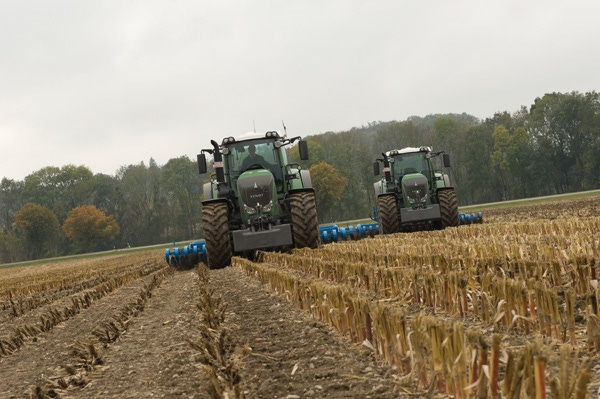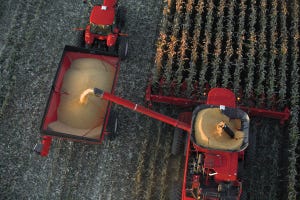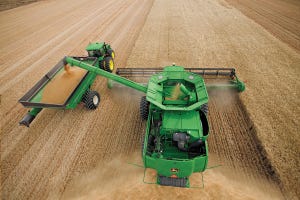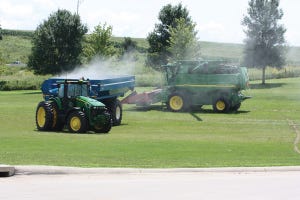January 10, 2012

This is the year when autonomous vehicles will emerge from research and development tests to farmers’ fields. By harvest, Case IH, John Deere and Kinze plan to have commercialized guidance systems that allow a tractor-and-grain-cart unit to be driven without operator input while unloading combines.
The operator will still be in the tractor cab with Case IH and John Deere systems, which some call supervised autonomy. With both systems, the combine takes over the steering and speed of the tractor pulling the grain cart as it draws near. The Kinze system, which will operate without anyone in the tractor cab, promises to be the first fully autonomous vehicle system for use in annual crops in the U.S.
Meanwhile, a driverless system introduced by Fendt in Europe this fall could be the first autonomous agricultural vehicle system in use in annual crops worldwide, assuming it is available for commercial use by the 2012 planting season. The Fendt system pairs a driverless tractor with an operator-driven tractor, which can remotely steer the following tractor to avoid obstacles.
R&D becomes reality
Autonomous vehicles have been the topic of university research and behind-the-scenes product development by manufacturers for years. But 2011 marked the first product announcements that will turn research and development rumors into reality.
“I believe 2011 may be a tipping point, the beginning of the race for the first commercialized autonomous vehicle,” says Kevin Monk, director of marketing for precision agriculture and construction for Case New Holland. “I believe many of the OEMs have the technical capability today, but are looking at how to ensure that customer value exceeds cost. Supervised autonomy [automated control, but with an operator present] is the first step.”
“John Deere has been exploring autonomous vehicles for many years,” says Robert Dyar, a product manager with the John Deere Intelligent Solutions Group. “Several years ago we showed an autonomous tractor working in a vineyard, so this isn’t anything new to us. Our goal with Machine Sync is to improve the efficiency and productivity of our equipment. Most producers are interested in that.”
Long-term impact
The impact of autonomous vehicles could be dramatic, expanding opportunities to improve productivity while opening the door to reassessing the most efficient equipment size.
“A grower could have three or four autonomous systems and plant around the clock,” says Susanne Kinzebaw Veatch, vice president of Kinze Manufacturing. “If you run around the clock, you don’t necessarily need a great big planter.”
“The reason farm machinery has gotten larger is that we needed to cover more acres with one operator,” Monk adds. “In the future, instead of a 60-ft. planter, a farmer might use six 10-ft. planters, still with one operator. If a grower can cover the same linear feet with multiple units, it could mean profound things for the industry.”
Case IH V2V system
 Case IH introduced the V2V system at the SIMA agricultural show in Paris in February 2011. Limited quantities of the system will be available for field installation on late-model Case IH combines and tractors in time for the 2012 U.S. corn harvest, according to Monk.
Case IH introduced the V2V system at the SIMA agricultural show in Paris in February 2011. Limited quantities of the system will be available for field installation on late-model Case IH combines and tractors in time for the 2012 U.S. corn harvest, according to Monk.
With the V2V system, the combine directs the tractor pulling the unloading cart to the active unloading area behind and to the left of the combine. Once the V2V-equipped tractor enters the unloading area, the combine takes control of the tractor, including steering and coordinating the speeds of the two vehicles to assure efficient unloading.
“One of the biggest benefits is increasing efficiency while reducing stress during unloading,” Monk says. “And the skill level of the driver doesn’t need to be as high.”
Various options for final configuration of the V2V system are still being considered. On test vehicles, the combine and tractor both have been guided by AFS AccuGuide real-time kinematic (RTK) navigation systems, as well as a secure radio link between the two vehicles. The system is expected to be limited to newer model vehicles with AFS Pro displays with a CANbus interface.
The price for the V2V system has not been set. For more information, visit www.caseih.com.
John Deere’s Machine Sync
 Beginning this year, John Deere customers will be able to automatically position grain carts alongside moving combines using Machine Sync. Introduced in late August, Machine Sync will be available on new S-Series combines and new and existing 60- and 70-Series combines.
Beginning this year, John Deere customers will be able to automatically position grain carts alongside moving combines using Machine Sync. Introduced in late August, Machine Sync will be available on new S-Series combines and new and existing 60- and 70-Series combines.
Machine Sync will network up to 10 machines in a 3-mile radius, which will improve overall harvest logistics, Dyar says.
“The real value is the logistics — the ability for everybody in the network to see where everybody else is on the screen,” he says. “It allows everybody to be proactive. Now the grain cart operator can see how full the grain tank is before the combine stops.”
Installing Machine Sync requires a GreenStar 3 2630 display in each vehicle, StarFire 3000 or ITC receivers, a dedicated machine communications radio and a software unlock. The system is compatible with SF1, SF2 or RTK correction signals when using the SF 3000 receiver’s built-in signal-sharing capability. RTK correction signals are required for ITC receivers.
Prices will be released this month. For more information, visit www.johndeere.com.
Kinze’s driverless grain cart
 Last summer, Kinze Manufacturing showcased a driverless tractor pulling a grain cart alongside a combine, as well as planting a row crop. Now the company says it will begin selling the grain cart system by harvest, with the planting system to follow at an undetermined date.
Last summer, Kinze Manufacturing showcased a driverless tractor pulling a grain cart alongside a combine, as well as planting a row crop. Now the company says it will begin selling the grain cart system by harvest, with the planting system to follow at an undetermined date.
“We used the harvesting system on our farm this fall. We are pleased with how it worked,” says Veatch, whose family owns Kinze Manufacturing.
If Kinze meets the fall timetable, it will be the first fully autonomous row-crop system available in the U.S.
The Kinze system marries off-the-shelf components, including GPS, radar, laser sensors and video cameras, with custom software that allows the system to react to field obstructions. It was developed in partnership with Jaybridge Robotics, which specializes in engineering design and software development for the robotics industry.
“Safety is critical for autonomous systems,” Veatch says. “The sensors we are using are proven. They will shut down the system if they confront an obstacle.”
The system uses radios for communication between the driverless vehicle and the combine. In field demonstrations last summer, after being summoned by the combine, a tractor pulled a grain cart alongside a combine for filling, then drove to a semitrailer for unloading by the semi-truck driver.
“We are getting a lot of positive feedback, especially from larger growers who find it hard to hire good qualified help,” Veach says. “I think growers are ready for this, especially if they are able to eliminate a hired hand at harvest.”
Pricing for the system has not been announced. For more information, visit www.kinze.com.
Fendt’s GuideConnect
 Although AGCO hasn’t announced if Fendt’s GuideConnect system will be introduced in North America, a prototype of the system introduced at Europe’s Agritechnica farm show in November 2011 hints at how pairing vehicles could improve productivity by enabling them to perform as a single unit.
Although AGCO hasn’t announced if Fendt’s GuideConnect system will be introduced in North America, a prototype of the system introduced at Europe’s Agritechnica farm show in November 2011 hints at how pairing vehicles could improve productivity by enabling them to perform as a single unit.
GuideConnect consists of an operator-driven tractor followed by an unmanned tractor, which is directed and monitored via RTK satellite navigation and secure radio communications between the two vehicles. After exchanging passwords, the system sets following distance and offset, and the unmanned tractor follows the lead vehicle as they perform the same field operation. At the end of the field, the guided tractor steers behind the lead tractor for turning. Implements are automatically raised and lowered before and after the turn.
To maneuver around obstacles, the operator in the lead tractor commands the drone tractor into a straight-behind driving mode until passing the obstacle, when the offset is reestablished. The follow vehicle stops automatically if satellite positioning with the lead tractor is interrupted.
AGCO expects to add sensors to the guided tractor to allow it to operate more autonomously — for example, to stop automatically for an obstacle. GuideConnect pricing has not been announced. To learn more, visit www.fendt.com.
About the Author(s)
You May Also Like






